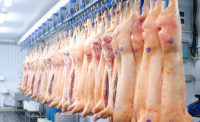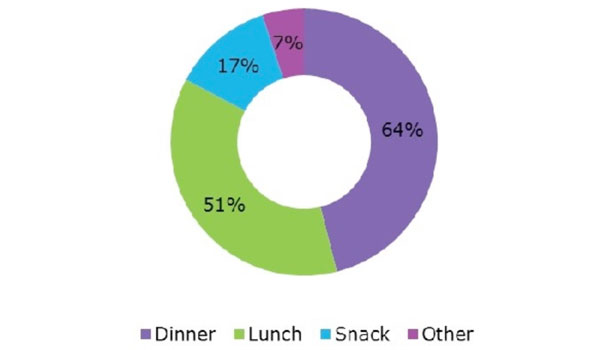Cooking & Chilling Systems
Exploring the frozen future
A slowly improving economy could send more consumers back to restaurants and away from frozen meals.












It doesn’t take a scientific study to know that people are increasingly pinched for time. With more demands eating into their leisure time, people have fewer opportunities to spend a long time in their kitchens to prepare a from-scratch dinner. They haven’t been going out to eat as much, either.
A look at the National Restaurant Association’s Restaurant Performance Index shows how the Great Recession has hurt the foodservice industry. For most of 2008 through 2012, the RPI’s Current Situation Index was below 100.0, which indicates that the foodservice industry was in a state of contraction. Although the numbers rebounded slightly in 2012 and 2013, indicating more optimism about the future, the restaurant industry still has struggled.
With little time to cook a meal and no spare funds to go to a restaurant, what did consumers do? They went to the supermarket and picked up an affordable, on-the-go meal. A 2012 retail study from Tyson Foods and Progressive Grocer magazine revealed that more than a quarter of respondents visit the supermarket at least once a week just to get something for dinner that night.
When they shopped, consumers went to the in-store deli. Two-thirds of deli purchases included cold, pre-packaged, to-go foods, reported the International Dairy-Deli-Bakery Association (IDDBA). More than one-third of shoppers said they desire more ready-to-eat meal items in their supermarket, according to a Packaged Facts survey, so the demand remains high.
Along with strong deli sales, frozen foods have benefited from the changing meal habits of American consumers. According to data from Mintel, the sales of frozen meals have topped $8 billion dollars since at least 2007. However, that sector has been in a steady decline since 2008, when frozen meal sales peaked at $8.477 billion. In 2012, sales were $8.082 billion, and according to Mintel’s data, the immediate outlook is a continued decline.
“Mintel estimates that sales will drop further into 2017 as buying power returns and many consumers increase their restaurant spending or maintain home cooking regimens that produce higher-quality meals than many frozen brands provide,” the group said in a just-released frozen meals report.
Frozen single-serve meals make up 61.3 percent of the frozen meal market share, with 2012 sales of $4.953 billion. That represents a 1.1 percent decline from 2010. Multi-serve frozen meals suffered a steeper decline of 7.1 percent, dropping to sales of $2.259 billion in 2012. They represent 28 percent of frozen-meal sales. Frozen side dishes, with sales of $362 million, and frozen pot pies, with sales of $507 million, account for the rest of the sales. While pot pies only represented 6.3 percent of the frozen-meal sector, they showed the largest growth. With sales growth of 21.9 percent from 2010 to 2012, they were the only segment in frozen meals that actually grew during that time.
Mintel estimates that frozen meal sales in 2017 will be approximately $7.63 billion, more than a $500 million drop from 2012. Along with the recovering economy, the study suggests that consumers are decreasing their use of frozen meals due to perceptions that they do not provide a nutritious meal. According to Experian Marketing Services’ NHCS, household consumption of frozen meals has declined from 52 percent in July 2007-September 2008 to 48 percent in August 2011-August 2012.
“More than four in 10 respondents also agree that most frozen dinners have little nutritional value,” the study adds. “Brands must do more to counter this perception to decelerate the downward slide set to occur between 2012 and 2017.”
Packaged Facts released its Frozen Foods in the U.S. survey in October 2012 that also noted the decline. It pointed to retailers’ increased focus on the fresh foods perimeter to the detriment of center store categories as well as competition from fresh foods (including prepared fresh foods) and shelf-stable foods as other factors.
“This situation presents huge challenges and opportunities for marketers and retailers,” the report stated. “Already, major marketers such as ConAgra, Heinz, and Unilever are slimming down and refocusing their brand portfolios. The crucial question is whether — and how — marketers and retailers can reinvent and re-emphasize frozen foods to re-attract consumers to these core center-store categories.”
Mintel notes that the processed nature of frozen foods leads to the perception that the meals are high in fat and sodium. As a contrast, more frozen meals are touting healthy claims on their packaging. Two of the most popular brands, Weight Watchers and Lean Cuisine, make note of the amount of calories, fat and sodium right on the front of the package, and they also highlight nutrient content levels, such as protein, fiber and calcium.
The brands also have expanded their products beyond the typical lunch/dinner entrees. Weight Watchers has added a Smart Beginnings line of frozen breakfast entrees, including oatmeal, pancakes and breakfast sandwiches. Lean Cuisine has added an Honestly Good line, which is an all-natural frozen line, and Salad Additions, which is a line of frozen salad toppings designed to be added to a fresh salad.
In a poll released earlier this year from Nestle USA (which makes frozen meals under the Lean Cuisine, Stouffer’s, Hot Pockets, Lean Pockets and DiGiorno brands) and Impulse Research, 27% said they mix frozen foods with fresh ingredients most of the time, and 64% said their meals often consist only of frozen food.
The study also reported that 23% said they prepare frozen meals at work. Of these respondents, 51% said they turn to frozen as a convenient lunch option, and 35% said frozen is a good option for a hot meal.
“This sneak peek into America’s freezers shows how ready-made meals have become must-have menu items,” said Christine Dahm, vice president of Marketing and Innovation, Nestle Prepared Foods Co. “With today’s hectic schedules, people appreciate not only how frozen meals fit with their lifestyles, but also the better quality, variety and convenience that is available to them. It’s fun to discover how they’re using frozen every day,” she said.
Nestle’s study showed that consumers also look to frozen meals as inspiration for their own culinary experiments. Thirty-one percent of those polled said they’ve tried to create their own version of a favorite frozen meal, while one in four of those surveyed said they’ve passed off frozen food as their own. Seventy-two percent said serving frozen food with a freshly made side dish or presenting it on a nice plate (65%) helps make it more believable as homemade.
Hot opportunities for frozen meals
Mintel’s study did point to several opportunities for frozen meal manufacturers to expand their market. Households with children reported more likelihood than those without to eat a variety of frozen meals, including single-serve and multi-serve frozen meals, low-fat frozen meals and pot pies. Parents who are looking for convenient and balanced meal but have no time to cook a homemade meal then become attractive potential customers.
“Brands must rely on other marketing means to target households with kids in the coming years, such as producing meals that kids love and illustrating to parents that frozen-meal brands can be trusted to provide kids with nutritious meals,” Mintel says.
Kid Cuisine, a brand of child-friendly frozen meals from ConAgra, touts the benefits of its meals. Its line of products includes kid favorites like Mac & Cheese, Chicken Nuggets, Deep-Dish Pizza and Fish Sticks, and the packages promote that the meals are a good source of protein and use words like “real,” “premium” and “whole grain,” where applicable.
Lunch and dinner remain the most popular times to eat frozen meals, and frozen-food companies have not heavily targeted the snack occasion. However, 17 percent of consumers polled said that they eat frozen meals or frozen pot pies as a snack, and one-third of respondents reported that they eat frozen meals because single-serve meals are an easy snack. Sliders, whether they be hamburgers, chicken sandwiches or some other small-portion items could be ideal to meet this consumer need, as well as other smaller-portion, frozen products.
Convenience, as expected, rules as the top reason why consumers buy frozen meals. Fifty-eight percent of those polled choose that as a reason why they brought the products. Increasingly, though, consumers want meals that are nutritious as well as convenient. Meals that are high in protein are popular with consumers — fortunately for those processors who supply the beef, pork and chicken. The most important characteristic — chosen by 69 percent of consumers — was that the meal contain a full serving of vegetables. Also mentioned as important health characteristics were all-natural, reduced sodium and reduced fat.
While improving the health profiles of frozen meals may help lessen the decline, Mintel notes that more must be done to reverse the downward trend that the frozen-foods category has seen.
“Brands also must consider offering new and interesting flavors to generate interest in the market,” the report states. “Indeed, substantial numbers of respondents would like to see a wider range of ethnic flavors and vegetarian meals, indicating that brands have many options to expand the types of products they offer and generate more interest in the market.”
Looking for a reprint of this article?
From high-res PDFs to custom plaques, order your copy today!














